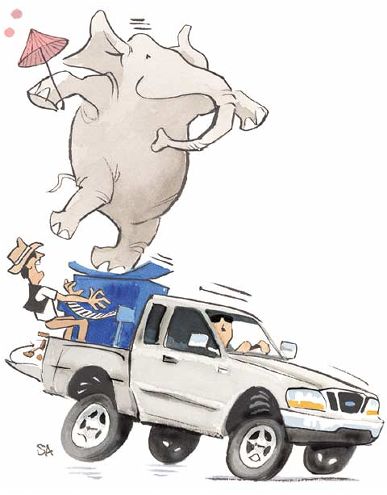
| 163 0410 Ttg01 Z
Droopy Rear EndQ:My 1999 Ranger's rear suspension seems weak. The rear drops dramatically, even with little payload. Can I simply add an extra leaf from the wrecking yard or do I have to go with an aftermarket overload system?
A:Adding a junkyard leaf to your spring pack would be a lot of work that can create numerous problems--so let's pass on that one. There are aftermarket add-a-leaf kits that'll notably lift and stiffen the rear suspension. This could be worthwhile for nonstop heavy work applications. Add-on helper springs produced by manufacturers like Hellwig Suspension (www.hellwigproducts.com; 800/367-5480) are designed to aid in supporting cargo loads without affecting the unloaded suspension performance. This may be the way to go if you're consistently carrying a decent payload, but I wouldn't be surprised if it stiffened up the ride to some degree. If hauling a significant cargo load isn't a full-time job, I'd suggest a pair of adjustable rear air shocks. No pressure's needed when there's no cargo, but when you load the truck, you can add pressure to raise it back to its original height. Carrying a small D/C air pump on board can make it convenient to change pressures. If the vehicle's unloaded ride height is below specifications in the rear, replace the springs.
Front-End Clunk
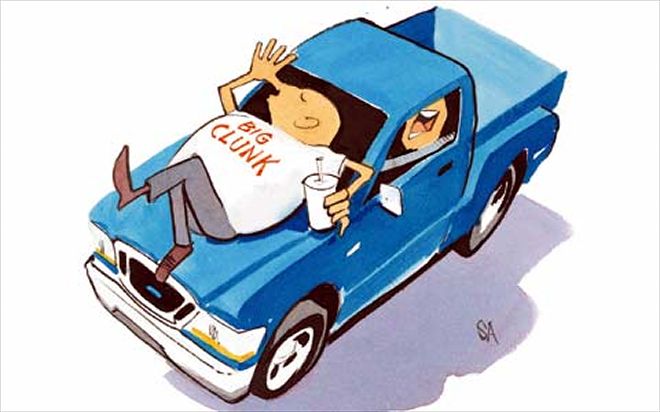
| 163 0410 Ttg02 Z
Q:I own a regular-cab 1999 Ford Ranger 4x4 automatic with 37,000 miles on it. After it's rained or snowed, if I start the truck and put it in drive or reverse, it won't move. I'll give it a little gas and get a big bang from the front end. It feels like something's locked up. The truck's fine when the weather's dry. I took it to the dealership--they cleaned the brake pads and rotors--but that didn't fix the problem. A private mechanic told me it could be the range-select sensor in the transmission.
A:The wet-only aspect doesn't seem to fit the picture. And a problem with the brakes like a seized caliper would typically result in steady drag, not a big bang. Carefully inspect the suspension and take your Ranger to a transmission shop. The mechanic may ask if you were in four-wheel drive when the problem occurred. It could be something binding up in the transmission or transfer case or could even be an axle assembly. It sounds like a delayed engagement of the transmission, due to low pressure or late hydraulic response. This would feel like you were in neutral while accelerating and gaining rpm. Then, once the hydraulic pressure finally arrives, you'd get the big bang, with a sudden forward or reverse engagement. There are a number of potential internal causes that focus around the transmission's hydraulic pump and valve body. The Digital Transmission Range Sensor shouldn't have an effect. Your transmission uses manual linkage and valves for engagement.
Duramax Valve FixQ:I'm having a problem with my 2002 Chevy truck with the Duramax diesel engine and 24,000 miles on it. I recently installed a Banks exhaust brake. As I was leaving Barstow, California, the Duramax blew a number-eight valve. The dealer is saying that because I added the Banks exhaust-brake system, Chevy won't warranty it.
A:You may want to log onto the Specialty Equipment Market Association (www.sema.org) Web site, where the group stores useful information on disputed warranty claims and your rights concerning the Magnuson-Moss Warranty Act. (You can also check out www.semasan.com and www.enjoythedrive.com.) An exhaust brake is designed to increase engine braking and preserve standard brakes on diesel-truck applications. There are several manufacturers, including Pacbrake, BD, Jacobs Vehicle Systems, and Gale Banks Engineering. Unlike a gasoline engine, the intake side of a diesel has no throttle plate to block incoming air. This limits the amount of backpressure available for engine braking when you take your foot off the accelerator and downshift the transmission. The exhaust brake is like a throttle plate on the exhaust side of the engine. When closed, it produces backpressure to help slow the vehicle and hopefully prevent brake fade while tackling a steep downgrade.
An exhaust brake does have the potential to cause engine damage. If backpressure goes beyond a certain limit, it'll produce excessive valve float, which means the pressure building up behind the exhaust valve will overpower the valve spring and prevent the valve from closing all the way. This can cause valve-to-piston contact, followed by catastrophic engine damage.
To find out more about what happened to your Duramax, I discussed it with the technician who tore it down. Three out of the four valves in cylinder number seven and one valve on the opposed bank of the engine in cylinder number eight were destroyed. The overall damage was so extensive that complete engine replacement was recommended, at an estimated cost of $22,000. Wow!
According to the service manager at the Chevy dealership, the GM zone representative denied the warranty claim once learning of the installation of a Banks Engineering exhaust-brake system, stating there have been previous cases of engine damage caused by this particular aftermarket part. I then spoke with Banks' director of technical communications. After inspecting the engine, that company believes the damage was caused by an internal defect; more specifically, the tip of one or more valve stems may have broken off. They assured us that the Banks exhaust brake has been thoroughly tested and doesn't exceed the engine's maximum backpressure specifications (55 psi), and they've had no reported cases of Duramax damage.
Here are the possible scenarios: A miscalibrated exhaust brake produced backpressure beyond limitations, causing valve float and piston contact. An internal engine flaw resulted in an expensive valvetrain breakdown. The driver exceeded the engine's rpm limitations (redline). Or, who knows, perhaps a combination of all of the above. I've checked with several shops that specialize in the Duramax, and none has come across any 6.6-liter internal engine failures or a Banks exhaust brake that caused damage.
On a related note, General Motors uses a Sab Wabco-produced exhaust brake on factory applications of the same engine in medium-duty commercial trucks. I've spoken with engineers who agree that a detailed inspection of the engine may not determine the exact cause of failure. You make the call. Truck Trend readers, this case is going to court. I'll keep you posted on the verdict.
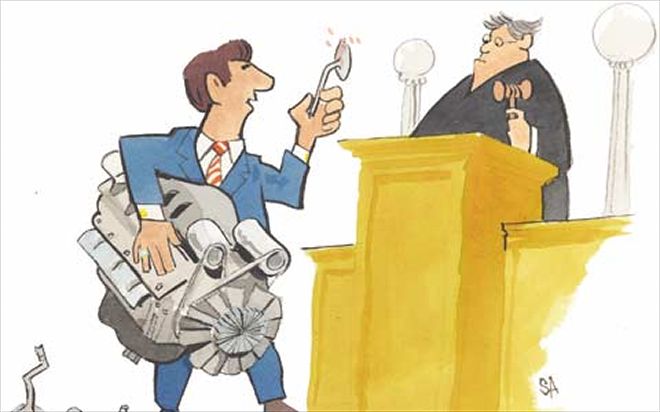
| 163 0410 Ttg03 Z
Is Diesel a Great Deal?Q:A common reason guys use to justify buying a big truck with a diesel engine is that they get better fuel economy and the truck is therefore cheaper to operate. I've been told that maintenance on a diesel is actually much more expensive than for a gas-engine vehicle. When you take all that into account, is the diesel really cheaper?
A:Diesels are more fuel efficient than gasoline engines, due to higher energy density (power-per-gallon) of the fuel, along with the advantages of direct fuel injection, which shoots the fuel directly into the combustion chamber. Diesel fuel has typically been less expensive because of fewer necessary refinements, but that doesn't always hold true in areas with limited diesel demand. Diesel engines are somewhat overbuilt by companies with heavy-duty commercial backgrounds to handle the high compression and abuse. This tends to give a diesel engine a much longer lifespan than a gas-burner; however, they also cost that much more to build and buy. Maintenance and repair of fuel systems can get involved, and fewer technicians available to do the job add to the cost. The bottom line: Diesels make sense if you regularly pull heavy loads and take advantage of the high torque at low engine speeds. It can also benefit long-term vehicle ownership. Otherwise, the added expense to purchase and maintain the truck may not be worth the cost and extra inconvenience. Light-duty diesels aren't always purchased for heavy workload or economic reasons, but occasionally for the rough-road persona that comes with the traditional clatter of diesel combustion.
Intermittent Converter Lockup
Q:I have a 1995 2500 Dodge Ram with the Cummins turbodiesel and an automatic transmission. I recently (10,000-20,000 miles ago) had to get a new transmission and decided to upgrade the torque converter to a Billet torque converter. Now when I'm driving it'll shift in and out of lockup, and it does this a lot. However, when the cruise control is on, it never happens. We took it to the dealership, and they couldn't get it to happen for them during a test drive and therefore couldn't figure out what it was.
A:The installation of an aftermarket drivetrain part as critical as an automatic transmission's torque converter always presents a risk. It may not mesh quite right with the original equipment, which can cause hard-to-diagnose and annoying conditions. A lockup converter actually locks the engine to the transmission at higher speeds and lighter loads for increased fuel economy. I spoke with a technician at Gale Banks engineering, and he mentioned that there was a mandatory installation of shift kit part #72603 with the use of any Banks Billet torque converter. If you haven't installed one, you need to. If you already have, you may want to call Banks tech support for further advice on the lockup converter's operation. Often, driveability symptoms will be camouflaged with the use of cruise control due to a steadier application of the throttle as compared to a driver's foot. There are hydraulic and electronic components that aren't part of the torque converter itself but still may be a source of the problem. Once the converter is ruled out, get it back to the shop that installed/overhauled the transmission.
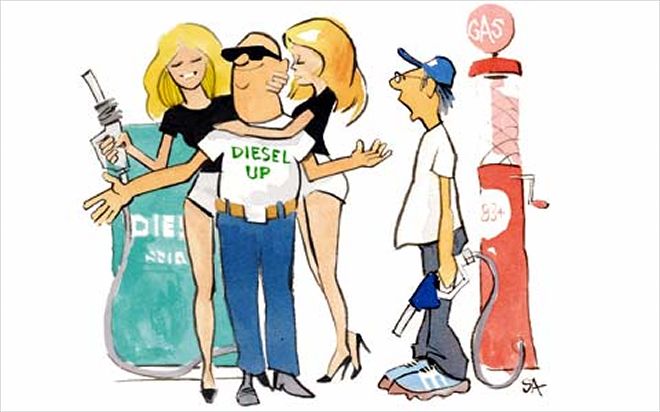
| 163 0410 Ttg04 Z
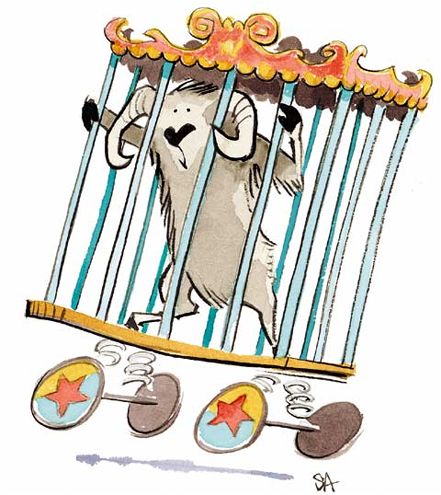
| 163 0410 Ttg05 Z
Starving for FuelQ:On a recent Colorado trip, my 1997 Grand Cherokee V-8 experienced what appeared to be fuel-starvation problems. At high altitude (8000-10,500 feet), temperatures 20 degrees F and lower, and on steep inclines, trying to maintain highway speeds caused the engine to cut out. Enough acceleration to make the transmission downshift caused the engine to quit. If I stop and restart, it would run all right, but only up to the same speed where it previously quit (about 55-60 depending on the grade). I can't duplicate the problem at home (Plano, Texas), mostly because I can't match the altitude, temperature, and steep grade, which seem to make a difference. I don't want to take it to a shop and have them run up a large bill guessing at the problem. Where should I start?
A:It's tough when the conditions needed to duplicate a problem aren't available. But you're on the right track in focusing on fuel delivery. When climbing a steep grade, the engine is working its hardest and consuming a high volume of fuel. The Grand Cherokee uses a fuel-pump module located at the fuel tank. It contains the fuel pump, filter, regulator, and fuel-gauge sending unit. A qualified shop can accurately test the system's fuel pressure, capacity, leakdown, and possible contamination. The pressure can be tested with a fuel-pressure gauge. The correct pressure from a strong pump will read 49.2 psi (+/- 5 psi). At this point, the shop can also test for a leakdown through the injectors or back past the fuel pump and can check for an external leak at a line or hose. The system's capacity should then be tested by opening the pressure line from the pump into a gasoline container. The pump should deliver at least a quarter of a liter of fuel in seven seconds. If not, there's either an obstruction in the fuel line or the module requires replacement. The fuel in the container can be visually inspected for contamination. There could be a less likely cause, which would require a repeat of the condition to diagnose. But the fuel-system tests are the first place to start and are certainly worth the expense.
Smaller-Tire WoesQ:I recently purchased a 1987 Dodge LE 250 pickup with a V-8. I'm trying to figure out a little problem. My speedometer reads 70 mph when I'm actually doing 60. Is it no longer working properly, or are the tire sizes on the truck too small? The current size is P255/65R16. As this is my first Dodge, please excuse my ignorance.
A:It looks like the two available production tire sizes on the 1987 Ram 250 were P215/85R16 and P235/85R16. The P255/65R16 tires are significantly smaller in diameter than either of the factory choices. This will give your truck a better jump on acceleration, lesser fuel mileage, and an inaccurately high speedometer reading. You'd get similar results from changing the rear-axle gear ratio. The best way to fix the problem would be to install the correct-size tires. There should be a tag inside the driver-side doorjamb designating the original equipment. Otherwise, you'll have to replace the inexpensive speedometer driven-gear located at the transmission. The correction is going to require a larger gear with more teeth. The correct gear can be calculated knowing the exact percentage of speedometer error and the original number of teeth on the drive and driven-gears. Give the Dodge parts department a call. They may be able to help you figure out what gears are available and which will work best to correct the problem.
Sticky Throttle JumpQ:I own a 2002 Chevrolet 2500 HD Crew Cab with the 8.1-liter engine, six-speed manual transmission, four-wheel drive, and 32,000 miles. The engine rpm will frequently jump up to 2000-2300 rpm and stay there for two to five seconds when I depress the clutch while attempting to shift gears or stop, especially when the truck's been running for only 20 to 60 seconds. Less frequently, the jump in rpm may happen after slowing from highway speeds and preparing to shift or stop. The accelerator isn't engaged, and I've made a point to ensure my foot is off the pedal. My dealer has investigated twice and recently reset the on-board computer to no avail.
A:Resetting or reprogramming the Powertrain Control Module (computer) may have been a stab in the dark. We hope the technician on the job scanned the system with the appropriate scan tool to check for trouble codes and any sign of incorrect data that may have led to the problem. The 8.1-liter V-8 uses a drive-by-wire throttle-control system, which GM refers to as Throttle Actuator Control. This technology eliminates the inefficiency of a throttle cable routed between the accelerator pedal and the throttle-body assembly on the engine. There's an Accelerator Pedal Position sensor located at the gas pedal that sends a data signal to the TAC module. The module, in turn, sends a command signal to the throttle-body assembly, where the throttle plate is opened and closed by an electric motor. It sounds complex, but is much more responsive and controllable than mechanical throttle control.
It's a good idea to leave the vehicle with the service-department personnel so they can perform an extended road test and confirm the intermittent racing of the engine. Then drive a similar vehicle and compare. The system is programmed to raise idle speed during cold operation and when changing gears to smooth out the shift. The combination of the two may be what you're experiencing. If both vehicles exhibit the same characteristics, we can presume it to be normal operation. Otherwise, the first thing to look for would be carbon buildup preventing the throttle plate from closing all the way. Then it's going to require a more detailed diagnosis. The technician may want to touch base with Chevy Technical Support for assistance.
How To Reach AlexIf you have a technical question regarding your pickup, SUV, or van, feel free to contact Alex, a master technician with the National Institute for Automotive Service Excellence. Send a letter to him in care of Truck Trend Garage, 831 S. Douglas Street, El Segundo, CA 90245, or e-mail us at
[email protected]. Please include the VIN with your question. Due to the volume of questions received every month, we cannot guarantee that everyone's question will be personally answered or will appear in the magazine.
Can't wait for help with a problem you're having with your Truck or SUV? Ask the expert we trust here at Truck Trend Garage--visit Alex Steele at www.RealWorldAutomotive.com.
 | 163 0410 Ttg01 Z
Droopy Rear End
| 163 0410 Ttg01 Z
Droopy Rear End | 163 0410 Ttg02 Z
Q:I own a regular-cab 1999 Ford Ranger 4x4 automatic with 37,000 miles on it. After it's rained or snowed, if I start the truck and put it in drive or reverse, it won't move. I'll give it a little gas and get a big bang from the front end. It feels like something's locked up. The truck's fine when the weather's dry. I took it to the dealership--they cleaned the brake pads and rotors--but that didn't fix the problem. A private mechanic told me it could be the range-select sensor in the transmission.
A:The wet-only aspect doesn't seem to fit the picture. And a problem with the brakes like a seized caliper would typically result in steady drag, not a big bang. Carefully inspect the suspension and take your Ranger to a transmission shop. The mechanic may ask if you were in four-wheel drive when the problem occurred. It could be something binding up in the transmission or transfer case or could even be an axle assembly. It sounds like a delayed engagement of the transmission, due to low pressure or late hydraulic response. This would feel like you were in neutral while accelerating and gaining rpm. Then, once the hydraulic pressure finally arrives, you'd get the big bang, with a sudden forward or reverse engagement. There are a number of potential internal causes that focus around the transmission's hydraulic pump and valve body. The Digital Transmission Range Sensor shouldn't have an effect. Your transmission uses manual linkage and valves for engagement.
Duramax Valve Fix
| 163 0410 Ttg02 Z
Q:I own a regular-cab 1999 Ford Ranger 4x4 automatic with 37,000 miles on it. After it's rained or snowed, if I start the truck and put it in drive or reverse, it won't move. I'll give it a little gas and get a big bang from the front end. It feels like something's locked up. The truck's fine when the weather's dry. I took it to the dealership--they cleaned the brake pads and rotors--but that didn't fix the problem. A private mechanic told me it could be the range-select sensor in the transmission.
A:The wet-only aspect doesn't seem to fit the picture. And a problem with the brakes like a seized caliper would typically result in steady drag, not a big bang. Carefully inspect the suspension and take your Ranger to a transmission shop. The mechanic may ask if you were in four-wheel drive when the problem occurred. It could be something binding up in the transmission or transfer case or could even be an axle assembly. It sounds like a delayed engagement of the transmission, due to low pressure or late hydraulic response. This would feel like you were in neutral while accelerating and gaining rpm. Then, once the hydraulic pressure finally arrives, you'd get the big bang, with a sudden forward or reverse engagement. There are a number of potential internal causes that focus around the transmission's hydraulic pump and valve body. The Digital Transmission Range Sensor shouldn't have an effect. Your transmission uses manual linkage and valves for engagement.
Duramax Valve Fix | 163 0410 Ttg03 Z
Is Diesel a Great Deal?
| 163 0410 Ttg03 Z
Is Diesel a Great Deal? | 163 0410 Ttg04 Z
| 163 0410 Ttg04 Z
 | 163 0410 Ttg05 Z
Starving for Fuel
| 163 0410 Ttg05 Z
Starving for Fuel